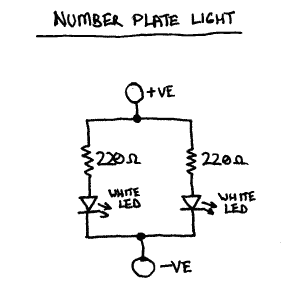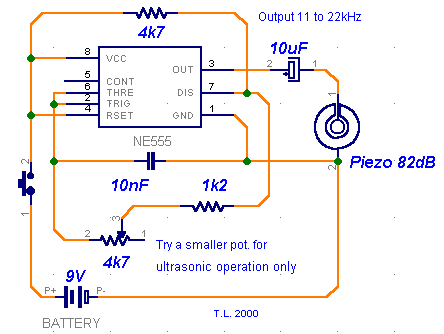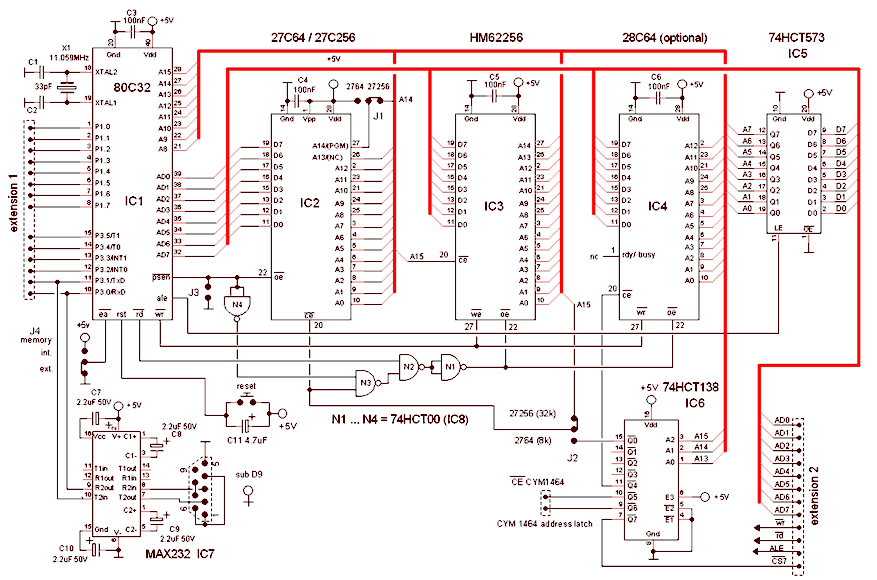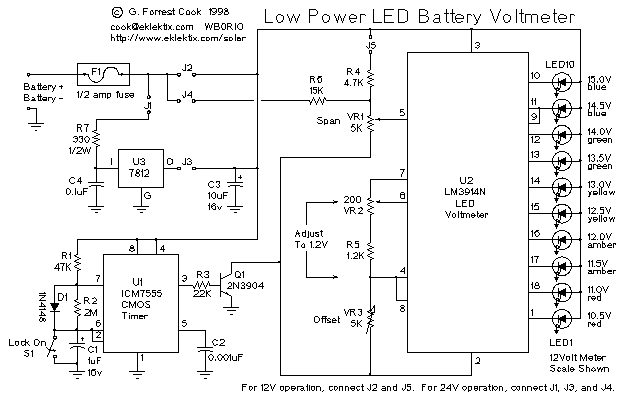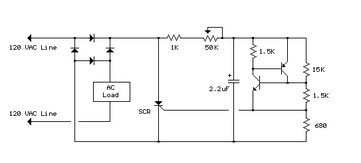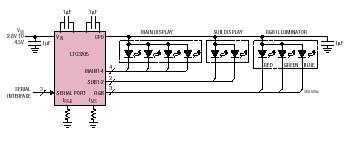
Ultra Bright LED Lamp
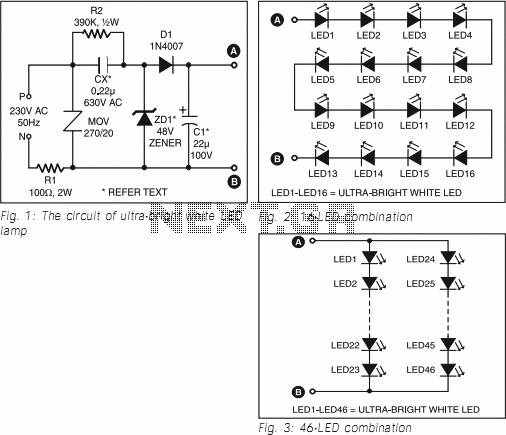
This ultra-bright white LED lamp operates on 230V AC with minimal power consumption. It is suitable for illuminating VU meters, SWR meters, and similar applications. Ultra-bright LEDs available in the market are priced between Rs 8 to 15. These LEDs emit a bright white light ranging from 1000 to 6000 mCd, similar to a welding arc, and function at 3 volts, 10 mA. The maximum voltage for these LEDs is 3.6 volts, with a current rating of 25 mA. Anti-static precautions should be observed when handling the LEDs. The LEDs packaged in water-clear plastic emit a spotlight, while diffused type LEDs provide a wide-angle radiation pattern. The circuit utilizes capacitive reactance to limit the current flowing through the LEDs when mains voltage is applied. Using only a series resistor for current limitation in mains operation would result in the resistor dissipating approximately 2 to 3 watts of power, whereas a capacitor does not dissipate power. The capacitor value is determined using the relationships involving capacitive reactance (XC in ohms), capacitance (C in farads), current through the LED (I in amperes), mains frequency (f in Hz), and the input mains voltage (Vrms). A 100-ohm, 2W series resistor is included to prevent heavy inrush current during transients. A Metal Oxide Varistor (MOV) at the input protects against surges or spikes. A 390-kilo-ohm, ½-watt resistor serves as a bleeder to provide a discharge path for capacitor Cx when the mains supply is disconnected. The zener diode in the output section prevents excessive reverse voltage levels across the LEDs during negative half cycles, limiting the voltage across the LEDs to the zener voltage during positive half cycles. AC capacitors should be used for Cx. A filter capacitor C1 across the output ensures flicker-free light. The circuit can be housed in a CFL round case, allowing it to be directly connected to an AC bulb holder socket. A series configuration of 16 LEDs provides a luminance (lux) equivalent to a 12W bulb. In contrast, two series configurations of 23 LEDs in parallel (totaling 46 LEDs) yield light output comparable to a 35W bulb. For a table lamp, 15 LEDs are appropriate. Diode D1 (1N4007) and capacitor C1 function as rectifying and smoothing components to deliver DC voltage to the LED array. For a 16-LED configuration, use a capacitor Cx rated at 0.22 µF, 630V; C1 rated at 22 µF, 100V; and a zener diode rated at 48V, 1W. For a 23-LED configuration, utilize Cx rated at 0.47 µF, 630V; C1 rated at 33 µF, 150V; and a zener diode rated at 69V, 1W. The total cost of this circuit, including the LEDs, ranges from Rs 200 to Rs 400.
The circuit design for the ultra-bright white LED lamp incorporates several critical components to ensure efficient operation and longevity. The use of capacitive reactance for current limiting is a key feature that enhances energy efficiency compared to traditional resistive methods. The capacitor's role in limiting current without significant power dissipation is crucial, particularly in applications where heat management is essential. The selection of a 100-ohm, 2W series resistor is a prudent choice to mitigate inrush currents, ensuring that the LEDs are not subjected to damaging voltage spikes at startup.
The inclusion of a MOV provides an additional layer of protection against transient voltage surges that could otherwise compromise the integrity of the circuit. The bleeder resistor (390-kilo-ohm, ½-watt) is essential for safely discharging Cx when the circuit is powered down, preventing potential shock hazards during maintenance or replacement of components.
The zener diode's function in the output section is vital, as it regulates the voltage across the LEDs, maintaining optimal operating conditions during both positive and negative half cycles of the AC supply. This regulation is particularly important in ensuring the longevity and reliability of the LEDs, which are sensitive to over-voltage conditions.
The choice of capacitors, specifically using AC-rated capacitors for Cx and filter capacitors for C1, is essential to ensure that the circuit operates safely and effectively under AC voltage conditions. The specified capacitance values for both configurations of LEDs (16 in series and 23 in series) are tailored to deliver the desired light output while ensuring that the circuit remains within safe operating limits.
Overall, this LED lamp circuit design exemplifies modern approaches to lighting technology, emphasizing energy efficiency, safety, and versatility in application. The ability to adapt the number of LEDs in series and parallel configurations allows for customization based on specific lighting requirements, making this design suitable for a range of uses from decorative lighting to functional illumination in various environments.This ultra-bright white LED lamp works on 230V AC with minimal power consumption. It can be used to illuminate VU meters, SWR meters, etc. Ultra-bright LEDs available in the market cost Rs 8 to 15. These LEDs emit a 1000-6000mCd bright white light like welding arc and work on 3 volts, 10 mA. Their maximum voltage is 3. 6 volts and the current is 25 mA. Anti-static precautions should be taken when handling the LEDs. The LEDs in water-clear plastic package emit spotlight, while diffused type LEDs have a wide-angle radiation pattern. This circuit (Fig. 1) employs capacitive reactance for limiting the current flow through the LEDs on application of mains voltage to the circuit.
If we use only a series resistor for limiting the current with mains operation, the limiting resistor itself will dissipate around 2 to 3 watts of power, whereas no power is dissipated in a capacitor. The value of capacitor is calculated by using the following relationships: where XC is capacitive reactance in ohms, C is capacitance in farads, I is the current through the LED in amperes, f is the mains frequency in Hz, and Vrms is the input mains voltage.
The 100-ohm, 2W series resistor avoids heavy inrush` current during transients. MOV at the input prevents surges or spikes, protecting the circuit. The 390-kilo-ohm, ½-watt resistor acts as a bleeder to provide discharge path for capacitor Cx when mains supply is disconnected. The zener diode at the output section prevents excess reverse voltage levels appearing across the LEDs during negative half cycles.
During positive half cycle, the voltage across LEDs is limited to zener voltage. Use AC capacitors for Cx. Filter capacitor C1 across the output provides flicker-free light. The circuit can be enclosed in a CFL round case, and thus it can be connected directly to AC bulb holder socket. A series combination of 16 LEDs (Fig. 2) gives a luminance (lux) equivalent of a 12W bulb. But if you have two series combinations of 23 LEDs in parallel (total 46 LEDs as shown in Fig. 3), it gives light equal to a 35W bulb. 15 LEDs are suitable for a table-lamp light. Diode D1 (1N4007) and capacitor C1 act as rectifying and smoothing elements to provide DC voltage to the row of LEDs.
For a 16-LED row, use Cx of 0. 22 F, 630V; C1 of 22 F, 100V; and zener of 48V, 1W. Similarly, for 23 23 LED combination use Cx of 0. 47 mF, 630V; C1 of 33 F, 150V; and zener of 69V, 1W. This circuit (inclusive of LEDs) costs Rs 200 to Rs 400. 🔗 External reference
The circuit design for the ultra-bright white LED lamp incorporates several critical components to ensure efficient operation and longevity. The use of capacitive reactance for current limiting is a key feature that enhances energy efficiency compared to traditional resistive methods. The capacitor's role in limiting current without significant power dissipation is crucial, particularly in applications where heat management is essential. The selection of a 100-ohm, 2W series resistor is a prudent choice to mitigate inrush currents, ensuring that the LEDs are not subjected to damaging voltage spikes at startup.
The inclusion of a MOV provides an additional layer of protection against transient voltage surges that could otherwise compromise the integrity of the circuit. The bleeder resistor (390-kilo-ohm, ½-watt) is essential for safely discharging Cx when the circuit is powered down, preventing potential shock hazards during maintenance or replacement of components.
The zener diode's function in the output section is vital, as it regulates the voltage across the LEDs, maintaining optimal operating conditions during both positive and negative half cycles of the AC supply. This regulation is particularly important in ensuring the longevity and reliability of the LEDs, which are sensitive to over-voltage conditions.
The choice of capacitors, specifically using AC-rated capacitors for Cx and filter capacitors for C1, is essential to ensure that the circuit operates safely and effectively under AC voltage conditions. The specified capacitance values for both configurations of LEDs (16 in series and 23 in series) are tailored to deliver the desired light output while ensuring that the circuit remains within safe operating limits.
Overall, this LED lamp circuit design exemplifies modern approaches to lighting technology, emphasizing energy efficiency, safety, and versatility in application. The ability to adapt the number of LEDs in series and parallel configurations allows for customization based on specific lighting requirements, making this design suitable for a range of uses from decorative lighting to functional illumination in various environments.This ultra-bright white LED lamp works on 230V AC with minimal power consumption. It can be used to illuminate VU meters, SWR meters, etc. Ultra-bright LEDs available in the market cost Rs 8 to 15. These LEDs emit a 1000-6000mCd bright white light like welding arc and work on 3 volts, 10 mA. Their maximum voltage is 3. 6 volts and the current is 25 mA. Anti-static precautions should be taken when handling the LEDs. The LEDs in water-clear plastic package emit spotlight, while diffused type LEDs have a wide-angle radiation pattern. This circuit (Fig. 1) employs capacitive reactance for limiting the current flow through the LEDs on application of mains voltage to the circuit.
If we use only a series resistor for limiting the current with mains operation, the limiting resistor itself will dissipate around 2 to 3 watts of power, whereas no power is dissipated in a capacitor. The value of capacitor is calculated by using the following relationships: where XC is capacitive reactance in ohms, C is capacitance in farads, I is the current through the LED in amperes, f is the mains frequency in Hz, and Vrms is the input mains voltage.
The 100-ohm, 2W series resistor avoids heavy inrush` current during transients. MOV at the input prevents surges or spikes, protecting the circuit. The 390-kilo-ohm, ½-watt resistor acts as a bleeder to provide discharge path for capacitor Cx when mains supply is disconnected. The zener diode at the output section prevents excess reverse voltage levels appearing across the LEDs during negative half cycles.
During positive half cycle, the voltage across LEDs is limited to zener voltage. Use AC capacitors for Cx. Filter capacitor C1 across the output provides flicker-free light. The circuit can be enclosed in a CFL round case, and thus it can be connected directly to AC bulb holder socket. A series combination of 16 LEDs (Fig. 2) gives a luminance (lux) equivalent of a 12W bulb. But if you have two series combinations of 23 LEDs in parallel (total 46 LEDs as shown in Fig. 3), it gives light equal to a 35W bulb. 15 LEDs are suitable for a table-lamp light. Diode D1 (1N4007) and capacitor C1 act as rectifying and smoothing elements to provide DC voltage to the row of LEDs.
For a 16-LED row, use Cx of 0. 22 F, 630V; C1 of 22 F, 100V; and zener of 48V, 1W. Similarly, for 23 23 LED combination use Cx of 0. 47 mF, 630V; C1 of 33 F, 150V; and zener of 69V, 1W. This circuit (inclusive of LEDs) costs Rs 200 to Rs 400. 🔗 External reference
